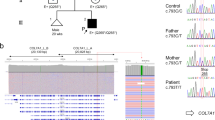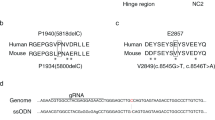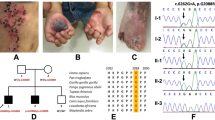Abstract
IN the hereditary blistering condition epidermolysis bullosa simplex, the skin blisters on trauma following rupture of epidermal basal cells. Clinical variations range from severely incapacitating, especially in early childhood, to mild forms that may not even present clinically. Dowling–Meara epidermolysis bullosa simplex is characterized by clusters of epidermal blisters and keratin clumping in the cytoplasm1; recent reports describe potentially causal mutations in keratin 14 (refs 2, 3). Here we describe a "complementary' mutation at the other end of the other keratin expressed by these cells (K5, coexpressed with K14), a change from a Glu to a Gly in the helix termination peptide, detected by altered antibody binding and confirmed by sequencing using the polymerase chain reaction. The two conserved helix boundary peptides are predicted to be essential for filament assembly, and the requirement for two complementary (type I and type II) keratins is absolute. Epidermolysis bullosa simplex diseases demonstrate the function of the keratin cytoskeleton in resisting compaction stresses which otherwise lead to cell lysis.
This is a preview of subscription content, access via your institution
Access options
Subscribe to this journal
Receive 51 print issues and online access
$199.00 per year
only $3.90 per issue
Buy this article
- Purchase on Springer Link
- Instant access to full article PDF
Prices may be subject to local taxes which are calculated during checkout
Similar content being viewed by others
References
Anton-Lamprecht, I. & Schnyder, U. W. Dermatology 164, 221–235 (1982).
Bonifas, J. M., Rothman, A. L. & Epstein, E. H. Science 254, 1202–1205 (1991).
Coulombe, P. A. et al. Cell 66, 1301–1311 (1991).
Moll, R., Franke, W. W., Schiller, D. L., Geiger, B. & Krepler, R. Cell 31, 11–24 (1982).
Mischke, D., Wille, G. & Wild, A. G. Am. J. hum. Genet. 46, 548–552 (1990).
Pruss, R. M. et al. Cell 27, 419–428 (1981).
Cooper, D., Schermer, A., Pruss, R. & Sun, T.-T. Differentiation 28, 30–35 (1984).
Magin, T. M., Hatzfeld, M. & Franke, W. W. EMBO J. 6, 2607–2615 (1987).
Stewart, M., Quinlan, R. A. & Moir, R. D. J. Cell Biol. 109, 225–234 (1989).
Albers, K. & Fuchs, E. J. Cell Biol. 105, 791–806 (1987).
Eckert, R. L. & Rorke, E. A. DNA 7, 337–345 (1988).
Lersch, R., Stellmach, V., Stocks, C., Giudice, G. & Fuchs, E. Molec. cell. Biol. 9, 3685–3697 (1989).
Cohen, C. & Parry, D. A. D. Trends Biochem. Sci. 11, 245–248 (1986).
Hatzfeld, M. & Weber, K. J. Cell. Sci. 99, 351–362 (1991).
Ishida-Yamamamoto, A. et al. J. invest. Derm. 97, 959–968 (1991).
Bonifas, J. M., Rothman, A. L. & Epstein, E. J. invest. Derm. 96, 550a (1991).
Albers, K. & Fuchs, E. J. Cell Biol. 108, 1477–1493 (1989).
Trevor, K. New Biol. 2, 1004–1014 (1990).
Vassar, R., Coulombe, P. A., Degenstein, L., Albers, K. & Fuchs, E. Cell 64, 365–380 (1991).
Rheinwald, J. G. & Green, H. Cell 6, 331–344 (1975).
Leigh, I. M., Tidman, M. J. & Eady, R. A. J. Br. J. Derm. 111, 527–532 (1984).
Chapman, S. J. & Eady, R, A. J. Eur. J. Cell Biol. 39, 352–359 (1985).
Stasiak, P. C., Purkis, P. E., Leigh, I. M. & Lane, E. B. J. invest. Derm. 92, 707–716 (1989).
Purkis, P. E. et al. J. Cell Sci. 97, 39–50 (1990).
Moll, R., Dhouailly, D. & Sun, T.-T. Virch. Arch. B 58, 105–113 (1988).
Lane, E. B. & Alexander, C. M. Semin. Cancer Biol. 1, 165–179 (1990).
Bartek, J. et al. Int. J. Cancer 46, 839–844 (1990).
Sambrook, J., Fritsch, E. F. & Maniatis, T. Molecular Cloning: A Laboratory Manual (Cold Spring Harbor Laboratory Press, New York, 1989).
Geisler, N. & Weber, K. EMBO J. 1, 1649–1656 (1982).
Author information
Authors and Affiliations
Rights and permissions
About this article
Cite this article
Lane, E., Rugg, E., Navsaria, H. et al. A mutation in the conserved helix termination peptide of keratin 5 in hereditary skin blistering. Nature 356, 244–246 (1992). https://doi.org/10.1038/356244a0
Received:
Accepted:
Issue Date:
DOI: https://doi.org/10.1038/356244a0
This article is cited by
-
A global, cross-sectional survey of patient-reported outcomes, disease burden, and quality of life in epidermolysis bullosa simplex
Orphanet Journal of Rare Diseases (2022)
-
Epidermolysis bullosa
Nature Reviews Disease Primers (2020)
-
The monoclonal antibody EPR1614Y against the stem cell biomarker keratin K15 lacks specificity and reacts with other keratins
Scientific Reports (2019)
-
Keratin gene mutations influence the keratinocyte response to DNA damage and cytokine induced apoptosis
Archives of Dermatological Research (2017)
-
Stabilizing mutations of KLHL24 ubiquitin ligase cause loss of keratin 14 and human skin fragility
Nature Genetics (2016)
Comments
By submitting a comment you agree to abide by our Terms and Community Guidelines. If you find something abusive or that does not comply with our terms or guidelines please flag it as inappropriate.



